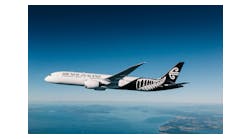June 28--SALALAH, Oman -- The flood of Gulf tourists flocking to the Omani coast rather than to the usual Levant holiday destinations is just one sign that the boom in the region's aviation sector will continue despite a change in Middle East travel trends, experts say. "Tourists may have changed to other destinations including Dubai, Turkey and Oman, but people will always continue to fly more and will even go back to their usual destinations. It's only a matter of time," said Adel Ali, CEO of Air Arabia, the organizer of Aviation and Media Summit 2013.
The challenges and opportunities faced by the intertwined aviation and tourism industries were highlighted Wednesday and Thursday during a summit hosted by the small southwestern Omani city of Salalah, where more than 70 media representatives and aviation experts from across the region gathered.
The rise of intra-GCC tourism -- which includes typical destinations such as Dubai as well as atypical ones like Salalah and Saudi city of Abha -- does not mean Lebanon, Jordan and and North African countries have fallen out of favor, Ali said in an interview on the sidelines of the conference.
"The creation of big intra-GCC tourism does not mean the demise of tourism in the Levant and elsewhere in the region. I believe it will actually increase on the long-term," he added.
"The more people travel, the more they want to do so. Overall, instead of monthlong vacations, we will start seeing tourists going on shorter holidays of three to four days to more destinations," Ali said.
Speaking on a conference panel, Ali said that even amid the Tunisian and Egyptian uprisings the sharp drop in tourism failed to translate into an equivalent slowdown in the aviation industry.
Expats flying to and from their troubled home countries to check on relatives and property amid the turmoil was one of the trends that kept aviation growth on the rise.
Similar trends persist across the region and very little seems to be deterring growth in the aviation sector.
Even though Lebanon saw tourism drop by over 12 percent in the first five months of 2013, the number of passengers at its only commercial airport increased by a significant 9.7 percent.
Middle East and other emerging markets will continue to drive growth in the global aviation market, said Andrew Gordon, head of Market Forecasts at Airbus, citing continued economic growth in the GCC, growth in tourism, business relationships with developing economies, and the rise of global aviation hubs in the region. as some of the reasons.
Traffic to and from the Middle East has grown by 236 percent over the last 10 years and prospects for the future are equally promising, he told a panel.
Passenger traffic in the Middle East will increase by 6.2 percent annually over the next 20 years, with airline fleets expected to grow three times by 2031, Gordon said, laying out Airbus forecasts for the region.
He told The Daily Star the Middle East continued to present a major market for the aircraft maker.
"[The Middle East] is a very big part of our backlog. Today the region represents 9 percent. It is a very important market ... particularly because we are selling all of our aircraft types," Gordon said.
Seven percent of all passenger aircraft ordered in the next 20 years will come from the Middle East, he added.
The 1,960 aircraft will have a market value of $408 billion and will include more than 1,000 comprising 826 twin-aisle aircraft and 345 very large aircraft.
Asked whether further taxation over emissions in Europe and elsewhere could slow Middle Eastern airlines' prospects for growth, Gordon admitted that one of the big risks facing aviation was environmental concerns, but said aircraft makers were striving to lower emissions further.
"The reality is that aviation represents 2 percent of man-made emissions and it will not be exceeding 2 percent in the future. We are doing everything we can to reduce emissions and we have already cut emissions and noise by 70 percent in the last 20 years," he said.
A significant portion of growth in the Middle East's aviation sector can be attributed to the rise of low-cost carriers, which are currently fueling growth in the industry, several panelists at the conference argued.
Low-cost airlines now represent 13 percent of the aviation market, up from less than 4 percent in 2006, according to Gordon.
The share is forecast to hit the global average of 25-30 percent in the coming few years, several experts said.
In 2012, Air Arabia managed to increase profits by 55 percent in the number of passengers by 23 percent. Growth is continuing this year and so far profits are up 12 percent while the number of passengers has increased by 22 percent, Ali told The Daily Star.
"People now want comfortable and affordable rides and they want the freedom to choose what kind of services they pay for," Ali said.
"If there is a future for aviation it is going to be low-cost."
Copyright 2013 - The Daily Star, Beirut, Lebanon




